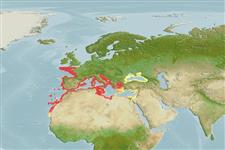Actinopterygii (ray-finned fishes) >
Perciformes (Perch-likes) >
Blenniidae (Combtooth blennies) > Blenniinae
Etymology: Blennius: Greek,blenios = mucus (Ref. 45335). More on author: Linnaeus.
Environment / Climate / Range
Ecology
Marine; demersal; depth range 10 - 400 m. Subtropical, preferred ?; 50°N - 20°N, 18°W - 42°E
Southeast Atlantic: Atlantic coast from Morocco to the English Channel. Also known from the Mediterranean and Black Sea.
Size / Weight / Age
Maturity: Lm ? range ? - ? cm
Max length : 20.0 cm TL male/unsexed; (Ref. 3397)
Dorsal
spines
(total): 11 - 12;
Dorsal
soft rays
(total): 14-16;
Anal
spines: 2;
Anal
soft rays: 15 - 16. Gill membranes not forming a fold across isthmus. Tentacles on nasal opening, above eye and on nape near first dorsal fin ray. Dentaries joined by suture. Lateral line reduced, discontinuous. Anterior part of dorsal fin conspicuously higher than posterior part.
Adults are found over hard bottoms. Mainly nocturnal, they feed on small invertebrates. Oviparous. Eggs are demersal and adhesive (Ref. 205), and are attached to the substrate via a filamentous, adhesive pad or pedestal (Ref. 94114). Eggs are laid under mussel-shells or stones and guarded by the male (Ref. 5981). Larvae are planktonic, often found in shallow, coastal waters (Ref. 94114). Spawn in April (Marseille) or July (England) (Ref. 5981).
Life cycle and mating behavior
Maturity | Reproduction | Spawning | Eggs | Fecundity | Larvae
Eggs are laid under mussel-shells or stones and guarded by male (Ref. 5981).
Wheeler, A., 1992. A list of the common and scientific names of fishes of the British Isles. J. Fish Biol. 41(suppl.A):1-37. (Ref. 5204)
IUCN Red List Status (Ref. 115185)
CITES (Ref. 94142)
Not Evaluated
Threat to humans
Harmless
Human uses
Fisheries: minor commercial
More information
ReferencesAquacultureAquaculture profileStrainsGeneticsAllele frequenciesHeritabilityDiseasesProcessingMass conversion
Tools
Special reports
Download XML
Internet sources
Estimates of some properties based on models
Phylogenetic diversity index (Ref.
82805): PD
50 = 0.7500 [Uniqueness, from 0.5 = low to 2.0 = high].
Bayesian length-weight: a=0.00813 (0.00616 - 0.01072), b=3.00 (2.92 - 3.08), in cm Total Length, based on LWR estimates for this species (Ref.
93245).
Trophic Level (Ref.
69278): 3.5 ±0.43 se; Based on food items.
Resilience (Ref.
69278): Medium, minimum population doubling time 1.4 - 4.4 years (Preliminary K or Fecundity.).
Vulnerability (Ref.
59153): Low to moderate vulnerability (30 of 100) .
